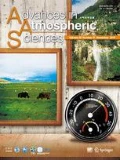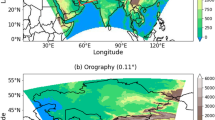Abstract
In the past several decades, dynamic global vegetation models (DGVMs) have been the most widely used and appropriate tool at the global scale to investigate vegetation–climate interactions. At the Institute of Atmospheric Physics, a new version of DGVM (IAP-DGVM) has been developed and coupled to the Common Land Model (CoLM) within the framework of the Chinese Academy of Sciences’ Earth System Model (CAS-ESM). This work reports the performance of IAP-DGVM through comparisons with that of the default DGVM of CoLM (CoLM-DGVM) and observations. With respect to CoLMDGVM, IAP-DGVM simulated fewer tropical trees, more “needleleaf evergreen boreal tree” and “broadleaf deciduous boreal shrub”, and a better representation of grasses. These contributed to a more realistic vegetation distribution in IAP-DGVM, including spatial patterns, total areas, and compositions. Moreover, IAP-DGVM also produced more accurate carbon fluxes than CoLM-DGVM when compared with observational estimates. Gross primary productivity and net primary production in IAP-DGVM were in better agreement with observations than those of CoLM-DGVM, and the tropical pattern of fire carbon emissions in IAP-DGVM was much more consistent with the observation than that in CoLM-DGVM. The leaf area index simulated by IAP-DGVM was closer to the observation than that of CoLM-DGVM; however, both simulated values about twice as large as in the observation. This evaluation provides valuable information for the application of CAS-ESM, as well as for other model communities in terms of a comparative benchmark.
摘 要
在过去的几十年, 全球植被动力学模式(DGVM)已经被广泛地应用, 且成为在全球尺度上研究植被–气候相互作用非常合适的工具. 在中国科学院大气物理研究所, 新版本的全球植被动力学模式(IAP-DGVM)已经建立, 且在中国科学院地球系统模式(CAS-ESM)的框架下已与陆表过程模式(CoLM)耦合. 本文通过与CoLM默认的DGVM(CoLM-DGVM), 观测的对比来评估IAP-DGVM的性能. 相对CoLM-DGVM, IAP-DGVM模拟了更少的热带树, 更多的寒带针叶常绿树和寒带阔叶落叶灌木以及更合理的草. 这些特征导致IAP-DGVM模拟了更真实的植被分布, 包括空间分布形态, 总的面积和组成. 除此之外, 参照于观测, IAP-DGVM模拟的碳通量比CoLM-DGVM的更加准确. IAP-DGVM模拟的总初级生产力和净初级生产力比CoLM-DGVM的更和观测一致, 而且相比于CoLM-DGVM, IAP-DGVM模拟的热带地区的火碳排放也和观测更加相像. 相对于CoLM-DGVM, IAP-DGVM模拟的叶面积指数也与观测更加接近. 但是, 两者模拟的叶面积指数的值都比观测大两倍. 本文的评估不仅为CAS-ESM的应用者提供有价值的信息, 也为其他模式团体提供比较的参考.
Similar content being viewed by others
References
Baker, I. T., L. Prihodko, A. S. Denning, M. Goulden, S. Miller, and H. R. da Rocha, 2008: Seasonal drought stress in the Amazon: Reconciling models and observations. J. Geophys. Res., 113, G00B01, https://doi.org/10.1029/2007JG000644.
Beer, C., and Coauthors, 2010: Terrestrial gross carbon dioxide uptake: Global distribution and covariation with climate. Science, 329, 834–838, https://doi.org/10.1126/science. 1184984.
Betts, R. A., P. M. Cox, M. Collins, P. P. Harris, C. Huntingford, and C. D. Jones, 2004: The role of ecosystem-atmosphere interactions in simulated Amazonian precipitation decrease and forest dieback under global climate warming. Theor. Appl. Climatol., 78, 157–175, https://doi.org/10.1007/s00704-004-0050-y.
Blok, D., M. M.P.D. Heijmans, G. Schaepman-Strub, A. V. Kononov, T. C. Maximov, and F. Berendse, 2010: Shrub expansion may reduce summer permafrost thaw in Siberian tundra. Global Change Biology, 16, 1296–1305, https://doi.org/10.1111/j.1365-2486.2009.02110.x.
Bonan, G. B., 1996: A land surface model (LSM Version 1.0) for ecological, hydrological, and atmospheric studies: Technical description and user’s guide. NCAR Tech. Note NCAR/TN-417+STR, https://doi.org/10.5065/D6DF6P5X.
Bonfils, C. J. W., T. J. Phillips, D. M. Lawrence, P. Cameron-Smith, W. J. Riley, and Z. M. Subin, 2012: On the influence of shrub height and expansion on northern high latitude climate. EnvironmentalResearchLetters, 7, 015503, https://doi. org/10.1088/1748-9326/7/1/015503.
Castillo, C. K. G., S. Levis, and P. Thornton, 2012: Evaluation of the new CNDV option of the community land model: Effects of dynamic vegetation and interactive nitrogen on CLM4 means and variability. J. Climate, 25, 3702–3714, https://doi. org/10.1175/JCLI-D-11-00372.1.
Charney, J., P. H. Stone, and W. J. Quirk, 1975: Drought in the Sahara: A biogeophysical feedback mechanism. Science, 187, 434–435, https://doi.org/10.1126/science.187.4175.434.
Ciais, P., and Coauthors, 1997: A three-dimensional synthesis study of δ18O in atmospheric CO2: 1. Surface fluxes. J. Geophys. Res., 102, 5857–5872, https://doi.org/10.1029/96JD 02360.
Cramer, W., and Coauthors, 2001: Global response of terrestrial ecosystem structure and function to CO2 and climate change: Results from six dynamic global vegetation models. Global Change Biology, 7, 357–373, https://doi.org/10.1046/j.1365-2486.2001.00383.x.
Dai, Y. J., and Q. C. Zeng, 1997: A land surface model (IAP94) for climate studies Part I: Formulation and validation in off-line experiments. Adv. Atmos. Sci., 14, 433–460, https://doi.org/10.1007/s00376-997-0063-4.
Dai, Y. J., and Coauthors, 2003: The common land model. Bull. Amer. Meteorol. Soc., 84, 1013–1023, https://doi.org/10.1175/BAMS-84-8-1013.
Dickinson, R. E., A. Henderson-Sellers, and P. J. Kennedy, 1993: Biosphere-Atmosphere Transfer Scheme (BATS) Version 1e as Coupled to the NCAR Community Climate Model. NCAR Tech. Note NCAR/TN-387+STR, 72 pp, https://doi.org/10.5065/D67W6959.
Erfanian, A., G. L. Wang, M. Yu, and R. Anyah, 2016: Multimodel ensemble simulations of present and future climates overWest Africa: Impacts of vegetation dynamics. Journal of Advances in Modeling Earth Systems, 8, 1411–1431, https://doi.org/10.1002/2016MS000660.
Falloon, P. D., R. Dankers, R. A. Betts, C. D. Jones, B. B. B. Booth, and F. H. Lambert, 2012: Role of vegetation change in future climate under the A1B scenario and a climate stabilisation scenario, using the HadCM3C Earth system model. Biogeosciences, 9, 4739–4756, https://doi.org/10.5194/bg-9-4739-2012.
Farquhar, G. D., J. Lloyd, J. A. Taylor, L. B. Flanagan, J. P. Syvertsen, K. T. Hubick, S. C. Wong, and J. R. Ehleringer, 1993: Vegetation effects on the isotope composition of oxygen in atmospheric CO2. Nature, 363, 439–443, https://doi.org/10.1038/363439a0.
Fraser, R. H., I. Olthof, M. Carrière, A. Deschamps, and D. Pouliot, 2011: Detecting long-term changes to vegetation in northern Canada using the Land sat satellite image archive. Environmental Research Letters, 6, 045502.
Friedlingstein, P., and Coauthors, 2006: Climate-carbon cycle feedback analysis: Results from the C4MIP model intercomparison. J. Climate, 19, 3337–3353, https://doi.org/10.1175/JCLI3800.1.
Guillevic, P., R. D. Koster, M. J. Suarez, L. Bounoua, G. J. Collatz, S. O. Los, and S. P. P. Mahanama, 2002: Influence of the interannual variability of vegetation on the surface energy balance—A global sensitivity study. Journal of Hydrometeorology, 3, 617–629, https://doi.org/10.1175/1525-7541(2002) 003<0617:IOTIVO>2.0.CO;2.
Holling, C. S., 1973: Resilience and stability of ecological systems. Annual Review of Ecology and Systematics, 4, 1–23, https://doi.org/10.1146/annurev.es.04.110173.000245.
IPCC, 2013: Climate Change 2013: The Physical Science Basis. Contribution of Working Group I to the Fifth Assessment Report of the Intergovernmental Panel on Climate Change. T. F. Stockeretal., Eds., Cambridge University Press, 1535 pp.
Ji, D., and Coauthors, 2014: Description and basic evaluation of Beijing Normal University Earth System Model (BNU-ESM) version 1. Geoscientific Model Development, 7, 2039–2064, https://doi.org/10.5194/gmd-7-2039-2014.
Lawrence, D., and K. Vandecar, 2015: Effects of tropical deforestation on climate and agriculture. Nat. Clim. Change, 5, 27–36, https://doi.org/10.1038/nclimate2430.
Lawrence, P. J., and T. N. Chase, 2007: Representing a new MODIS consistent land surface in the Community Land Model (CLM 3.0). J. Geophys. Res., 112, G01023, https://doi. org/10.1029/2006JG000168.
Levis, S., G. B., Bonan, M. Vertenstein, and K. Oleson, 2004: The Community Land Model’s dynamic global vegetation model (CLM-DGVM): Technical description and user’s guide. NCAR Tech. Note TN-459+IA, 50 pp, https://doi.org/10.5065/D6P26W36.
Li, F., and D. M. Lawrence, 2017: Role of fire in the global land water budget during the twentieth century due to changing ecosystems. J. Climate, 30, 1893–1908, https://doi.org/10.1175/JCLI-D-16-0460.1.
Li, F., X. D. Zeng, and S. Levis, 2012: A process-based fire parameterization of intermediate complexity in a Dynamic Global Vegetation Model. Biogeosciences, 9, 2761–2780, https://doi.org/10.5194/bg-9-2761-2012.
Li, F., S. Levis, and D. S. Ward, 2013: Quantifying the role of fire in the Earth system—Part1: Improved global fire modeling in the Community Earth System Model (CESM1). Biogeosciences, 10, 2293–2314, https://doi.org/10.5194/bg-10-2293-2013.
Li, F., B. Bond-Lamberty, and S. Levis, 2014: Quantifying the role of fire in the Earth system—Part 2: Impact on the net carbon balance of global terrestrial ecosystems for the 20th century. Biogeosciences, 11, 1345–1360, https://doi.org/10.5194/bg-11-1345-2014.
Li, F., D. M. Lawrence, and B. Bond-Lamberty, 2017: Impact of fire on global land surface air temperature and energy budget for the 20th century due to changes within ecosystems. Environmental Research Letters, 12, 044014, https://doi.org/10.1088/1748-9326/aa6685.
Li, Q., and Y. K. Xue, 2010: Simulated impacts of land cover change on summer climate in the Tibetan Plateau. Environmental Research Letters, 5, 015102, https://doi.org/10.1088/1748-9326/5/1/015102.
Myers-Smith, I. H., and Coauthors, 2011: Shrub expansion in tundra ecosystems: dynamics, impacts and research priorities. Environmental Research Letters, 6, 045509, https://doi.org/10.1088/1748-9326/6/4/045509.
Peng, C. H., 2000: From static biogeographical model to dynamic global vegetation model: A global perspective on modelling vegetation dynamics. Ecological Modelling, 135(1), 33–54, https://doi.org/10.1016/S0304-3800(00)00348-3.
Pielke, R. A., R. Avissar, M. Raupach, A. J. Dolman, X. B. Zeng, and A. S. Denning, 1998: Interactions between the atmosphere and terrestrial ecosystems: Influence on weather and climate. Global Change Biology, 4, 461–475, https://doi.org/10.1046/j.1365-2486.1998.t01-1-00176.x.
Qian, T. T., A. G. Dai, K. E. Trenberth, and K. W. Oleson, 2006: Simulation of global land surface conditions from 1948 to 2004. Part I: Forcing data and evaluations. Journal of Hydrometeorology, 7, 953–975, https://doi.org/10.1175/JHM540.1.
Quillet, A., C. H. Peng, and M. Garneau, 2010: Toward dynamic global vegetation models for simulating vegetation-climate interactions and feedbacks: Recent developments, limitations, and future challenges. Environmental Reviews, 18, 333–353, https://doi.org/10.1139/A10-016.
Randerson, J. T., G. R. Van Der Werf, L. Giglio, G. J. Collatz, and P. S. Kasibhatla. 2015: Global Fire Emissions Database, Version 4, (GFEDv4). ORNL DAAC, Oak Ridge, Tennessee, USA, https://dx.doi.org/10.3334/ORNLDAAC/1293.
Restrepo-Coupe, N., and Coauthors, 2017: Do dynamic global vegetation models capture the seasonality of carbon fluxes in the Amazon basin? A data-model intercomparison. Global Change Biology, 23, 191–208, https://doi.org/10.1111/gcb. 13442.
Scheffer, M., and Coauthors, 2009: Early-warning signals for critical transitions. Nature, 461, 53–59, https://doi.org/10.1038/nature08227.
Seddon, A. W. R., M. Macias-Fauria, P. R. Long, D. Benz, and K. J. Willis, 2016: Sensitivity of global terrestrial ecosystems to climate variability. Nature, 531, 229–232, https://doi.org/10.1038/nature16986.
Sitch, S., and Coauthors, 2003: Evaluation of ecosystem dynamics, plant geography and terrestrial carbon cycling in the LPJ dynamic global vegetation model. Global Change Biology, 9, 161–185, https://doi.org/10.1046/j.1365-2486.2003.00569.x.
Song, X., X. D. Zeng, J. W. Zhu, and P. Shao, 2016: Development of an establishment scheme for a DGVM. Adv. Atmos. Sci., 33, 829–840, https://doi.org/10.1007/s00376-016-5284-y.
Sturm, M., J. Holmgren, J. P. McFadden, G. E. Liston, F. S. Chapin III, and C. H. Racine, 2001: Snow-shrub interactions in Arctic tundra: A hypothesis with climatic implications. J. Climate, 14, 336–344, https://doi.org/10.1175/1520-0442(2001)014<0336:SSIIAT>2.0.CO;2.
Xue, Y. K., F. De Sales, R. Vasic, C. R. Mechoso, A. Arakawa, and S. Prince, 2010: Global and seasonal assessment of interactions between climate and vegetation biophysical processes: A GCM study with different land-vegetation representations. J. Climate, 23, 1411–1433, https://doi.org/10.1175/2009JCLI3054.1.
Yu, M., G. L. Wang, and J. S. Pal, 2016: Effects of vegetation feedback on future climate change over West Africa. Climate Dyn., 46, 3669–3688, https://doi.org/10.1007/s00382-015-2795-7.
Zeng, X. D., 2010: Evaluating the dependence of vegetation on climate in an improved dynamic global vegetation model. Adv. Atmos. Sci., 27, 977–991, https://doi.org/10.1007/s00376-009-9186-0.
Zeng, X. D., F. Li, and X. Song, 2014: Development of the IAP dynamic global vegetation model. Adv. Atmos. Sci., 31, 505–514, https://doi.org/10.1007/s00376-013-3155-3.
Zeng, X. D., X. B. Zeng, and M. Barlage, 2008: Growing temperate shrubs over arid and semiarid regions in the Community Land Model-Dynamic Global Vegetation Model. Global Biogeochemical Cycles, 22, GB3003, https://doi.org/10.1029/2007GB003014.
Zhao, M. S., and S.W. Running, 2010: Drought-induced reduction in global terrestrial net primary production from 2000 through 2009. Science, 329, 940–943, https://doi.org/10.1126/science. 1192666.
Zhu, J.W., and X. D. Zeng, 2015: Comprehensive study on the influence of evapotranspiration and albedo on surface temperature related to changes in the leaf area index. Adv. Atmos. Sci., 32(7), 935–942, https://doi.org/10.1007/s00376-014-4045-z.
Zhu, J. W., and X. D. Zeng, 2016: Influences of the interannual variability of vegetation LAI on surface temperature. Atmos. Oceanic Sci. Lett., 9(4), 292–297, https://dx.doi.org/10.1080/16742834.2016.1189800.
Zhu, J. W., and X. D. Zeng, 2017: Influences of the seasonal growth of vegetation on surface energy budgets over middle to high latitudes. International Journal of Climatology, 37, 4251–4260, https://doi.org/10.1002/joc.5068.
Acknowledgements
This work was supported by the National Major Research High Performance Computing Program of China (Grant No. 2016YFB02008) and the National Natural Science Foundation of China (Grant Number 41705070). Fang LI and Xiang SONG are supported by the National Natural Science Foundation of China (Grant Numbers 41475099 and 41305096).
Author information
Authors and Affiliations
Corresponding author
Electronic supplementary material
Rights and permissions
About this article
Cite this article
Zhu, J., Zeng, X., Zhang, M. et al. Evaluation of the New Dynamic Global Vegetation Model in CAS-ESM. Adv. Atmos. Sci. 35, 659–670 (2018). https://doi.org/10.1007/s00376-017-7154-7
Received:
Revised:
Accepted:
Published:
Issue Date:
DOI: https://doi.org/10.1007/s00376-017-7154-7



